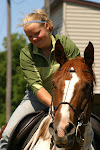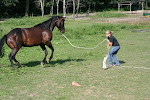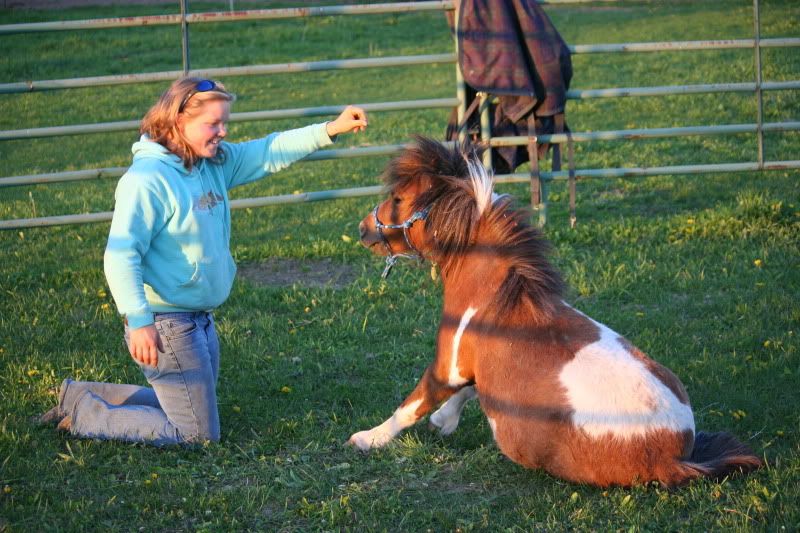 Anyway, most of the things that Linda had initially suggested for exercises while riding Crest are exercises (partial disengagement!) that are better set up for success, especially with a more impulsive horse, if they're done on a rail. What needs to be done is this: First, starting out, we need to establish some walk/trot/walk transitions. In the downward transitions, I'll use partial disengagement to "push" Crest down into the walk from trot, starting in his ribs and inside hind leg. I'll hold that until he can easily flow and relax in the walk, and he stretches his neck down. (See photo--though it looks like he's about to bash his head on the panel, I promise he was just stretching!)
Anyway, most of the things that Linda had initially suggested for exercises while riding Crest are exercises (partial disengagement!) that are better set up for success, especially with a more impulsive horse, if they're done on a rail. What needs to be done is this: First, starting out, we need to establish some walk/trot/walk transitions. In the downward transitions, I'll use partial disengagement to "push" Crest down into the walk from trot, starting in his ribs and inside hind leg. I'll hold that until he can easily flow and relax in the walk, and he stretches his neck down. (See photo--though it looks like he's about to bash his head on the panel, I promise he was just stretching!)Once those are smooth, I need to ask Crest up into a canter, using proper fluidity and core strength, cantering in my body (as opposed to the semi-fetal, fear-based squeeze and scream that I used to do, that usually results in Crest trotting like a dressage horse on steroids, and me about falling off). Once in canter, I'll allow a couple of strides at most, and use the same partial disengagment concept to bring him down to walk again. Rinse and repeat.
However, as I mentioned before, all this requires a rail of sorts. So whilst we wait for our arena, Crest and I have been preparing to ride by playing with partial disengagement online. I must confess, I felt like a total fool the other night when I had this realization. Parelli is so much about preparing online for what you want to do in the saddle, and yet I had not connected the dots from the ground exercise of partial disengagement to the saddle. I had taught both of my horses partial disengagement online months ago, as a means to encourage longitudinal flexion online. But I had not used it as a means to encourage relaxed transitions! So, that's what we're playing with now. Crest learned very quickly what I was searching for, and currently (as of 7/7/10, last I played with him), he's doing beautiful trot/walk transitions, beautiful (SMOOTH) canter/trot transitions, and is starting to find some rhythm in his canter/walk transitions, all on about 18 feet of the 22' line.
So that's where we're at for now. The journey SINCE the lesson has been so fulfilling in and of itself, I just am loving this process :)
So savvy on, and keep your eyes peeled for another addition to the "Ohio Recap" series, as I come to understand and dissect Crest's tendencies as a learner!









1 comment:
Great recap, Fran! I can't wait to hear more since I had to stay home and missed the Ohio event.
Petra Christensen
1Star Parelli Junior Instructor
Post a Comment